Homeowners Insurance
Which Colleges and Universities Have the Most Crime?
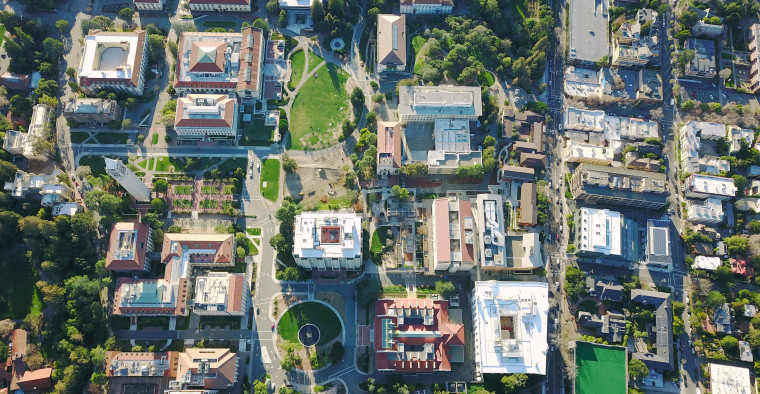
ValuePenguin calculated the likelihood that students will experience different types of crime at colleges and universities across the nation during a four-year enrollment. Nationally, larceny is the most common property crime in colleges, while rape is the most common violent crime.
About 1.06 in 1,000 students are affected by violent crimes, while property crime affects about 22 in every 1,000 students.
Contents
There's not a clear distinction between crime at rural and urban colleges. Also, the country's largest colleges aren't necessarily safer than its smaller schools. Finally, although students far outnumber law enforcement officers at universities, we didn't find a correlation between the amount of crime and the presence of law enforcement.
Key findings
- Overall, Florida SouthWestern State College has the lowest probability for property crime in the country, with about three victims for every 1,000 students per four-year period.
- University of North Georgia's students are the least likely to experience violent crime, where less than one in 1,000 students is a victim.
- Among large universities, Utah State University has the least property crime in the country, while Utah Valley University has the lowest number of violent crimes per 1,000 students.
- Contrary to popular belief, urban schools don't always have higher rates of crime than schools in suburban or rural areas.
Where does the least crime occur: Florida SouthWestern State College and North Georgia University
We compared the probability that students at universities and colleges across the United States would experience a property or violent crime over a four-year period. Overall, the school with the lowest chances for property crime is Florida SouthWestern State College in Ft. Myers. Here, slightly more than three in 1,000 students are affected by property crime over the course of a typical enrollment. Its chances for both types of crime don't rise above the median rate.
The risk of violent crime, which includes murder, robbery and aggravated assault, is also low at Florida SouthWestern State College. Fewer than one in 1,000 students are at risk of becoming a victim of violent crime during a four-year stay.
At the University of North Georgia, students are the least likely of any school we surveyed to be victims of violent crime. Here, there's a 0.005% chance of experiencing violent crime — about one student below the national median.
Among community colleges, students at Central Texas College have the lowest overall chance of encountering property crime. In four years, only about two in 1,000 students are affected. Also, fewer than one in 1,000 students is the victim of violent crime at Central Texas.
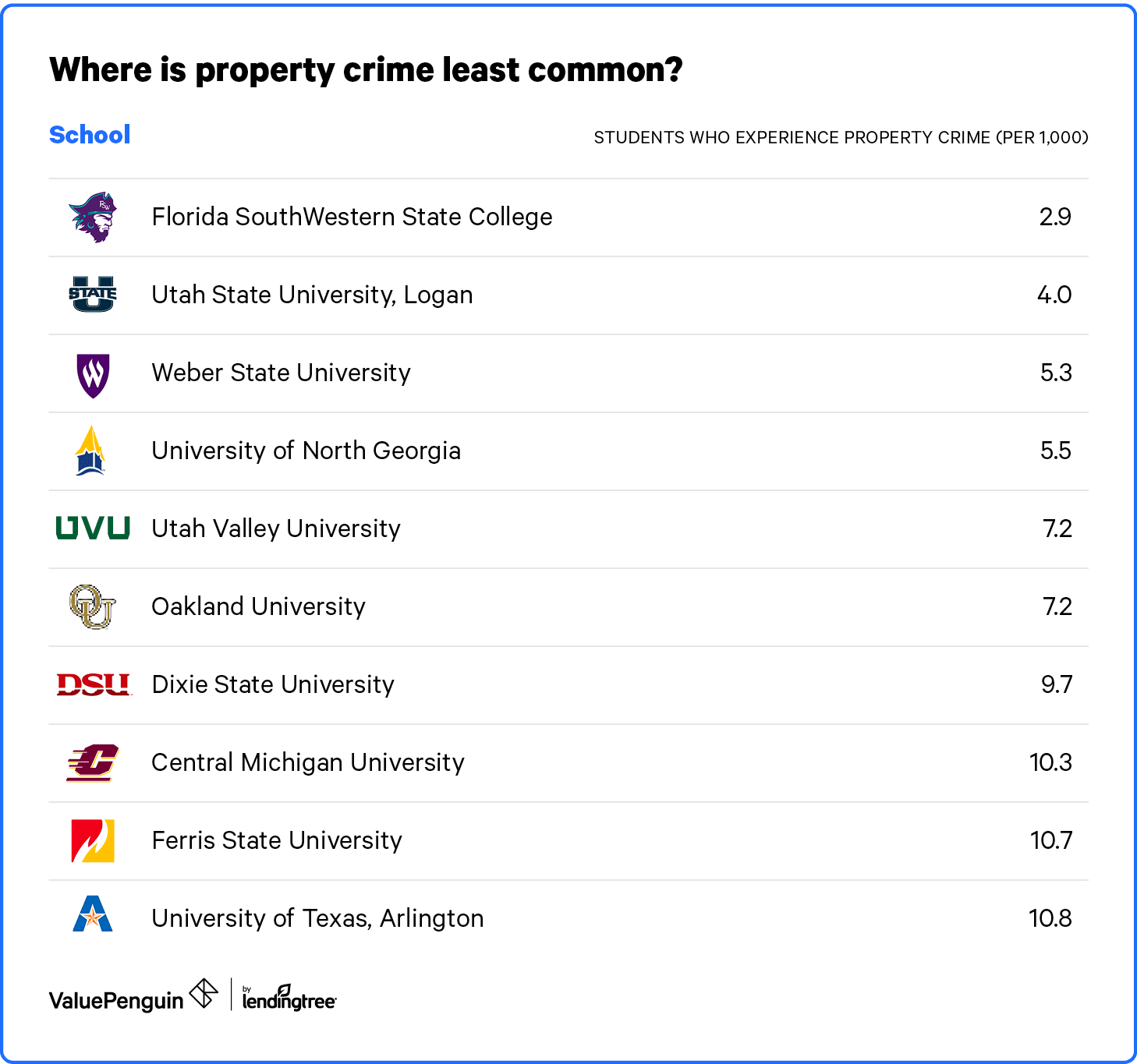
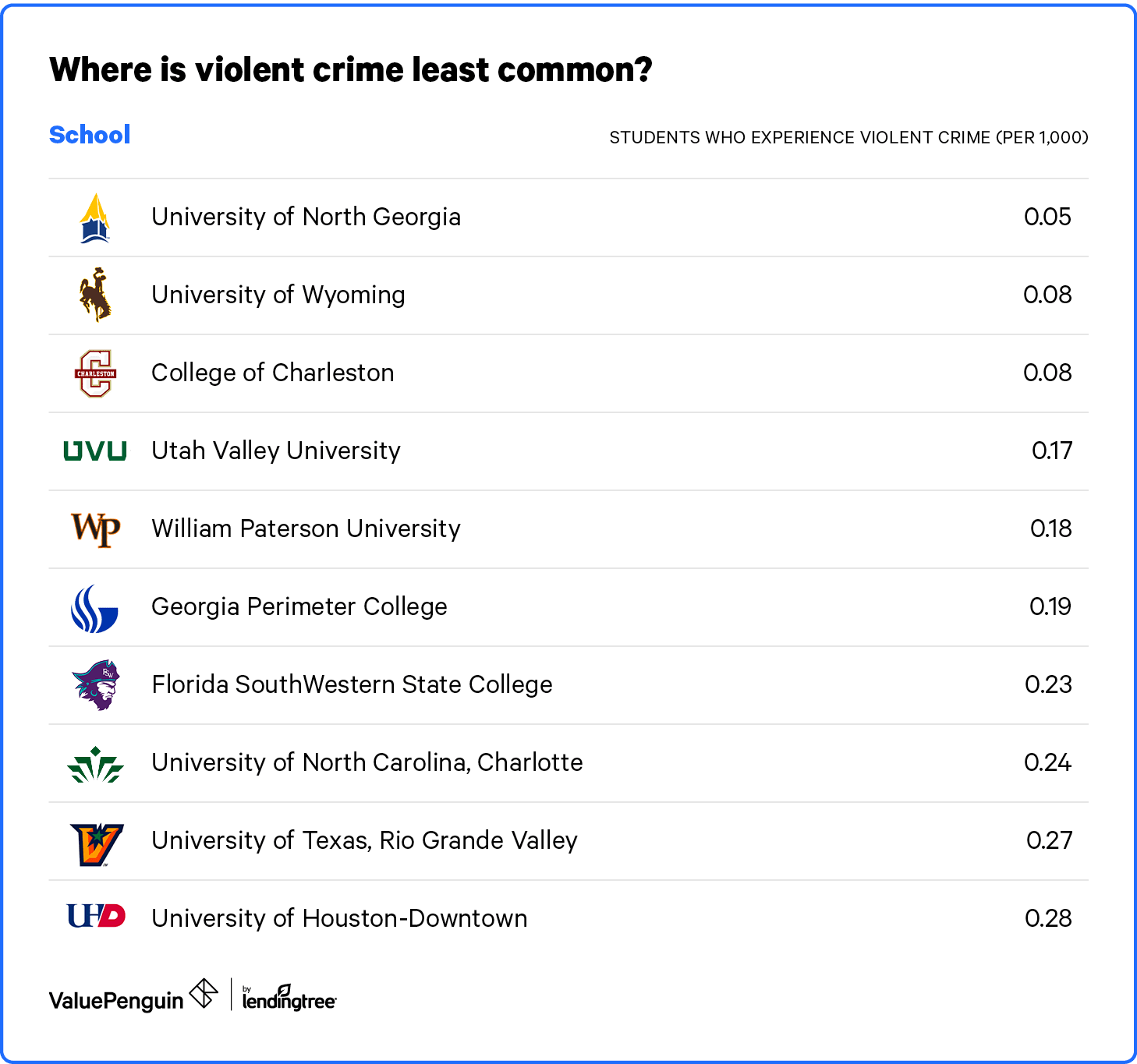
Crime at two of Utah's colleges is the most uncommon among the country's largest schools, while UCLA and University of California, Berkeley have the worst crime rates
We used our analysis of the FBI's crime data at universities and colleges to assess the safety at the nation's 50 largest schools. Of these schools, students at Utah State University have the lowest chance of experiencing property crime compared to the country's other large colleges.
In addition, students at Utah Valley University have the lowest chance of experiencing violent crime compared to students attending the country's other largest colleges.
Property crime at the country's largest schools
Utah State University has the lowest rate of property crime among the country's large universities. About four in 1,000 students here stand to become victims of property crime in a four-year stay. Violent crime is low, too. Less than one in 1,000 students are at risk of becoming a victim of a violent crime.
Conversely, students at the University of California, Berkeley have the greatest probability of experiencing property crime compared to enrollees at the nation's other largest schools. There are about 71 reported property crimes per 1,000 students during the course of a four-year period — about a 7.1% chance of being affected.
Violent crime at the country's largest schools
The University of California, Los Angeles has the highest probability of violent crime among its student body at about eight incidents per 1,000 enrollees per four-year period. Most violent crime at UCLA takes the form of aggravated assault, as is the case with most universities in this study.
At Utah Valley University, students have a comparatively lower chance of encountering violent crime. Here, students only have a 0.02% chance of being the victim of a violent crime in four years. As with UCLA, students who are impacted by violent crime have a higher chance of the crime being aggravated assault.
Colleges where you're least likely to experience crime
The following graphic shows the colleges that experience the least crime overall in the United States, ordered from least- to most- likely to experience crime. To be included on this list, the schools had to have lower rates of property and violent crime than the medians of both respective categories. This means that some colleges that have low rates of one type of crime and high rates of another are excluded from this list.
Marquette University and Vanderbilt University have the most crime among schools we surveyed
Students at Marquette University have the highest probability of being the victim of a violent crime. Still, like other schools, violent crime at Marquette occurs less frequently than property crime. At Marquette, nearly 10 in 1,000 students are affected over the course of a four-year term — a 1% chance of being a victim of a violent crime.
The school where students are most likely to experience property crime is Vanderbilt University, where 109 students per 1,000 are victims in every four-year period. This means there's an 11% chance a student will be the victim of property crime at Vanderbilt.
Graphic: Where is violent crime most common?
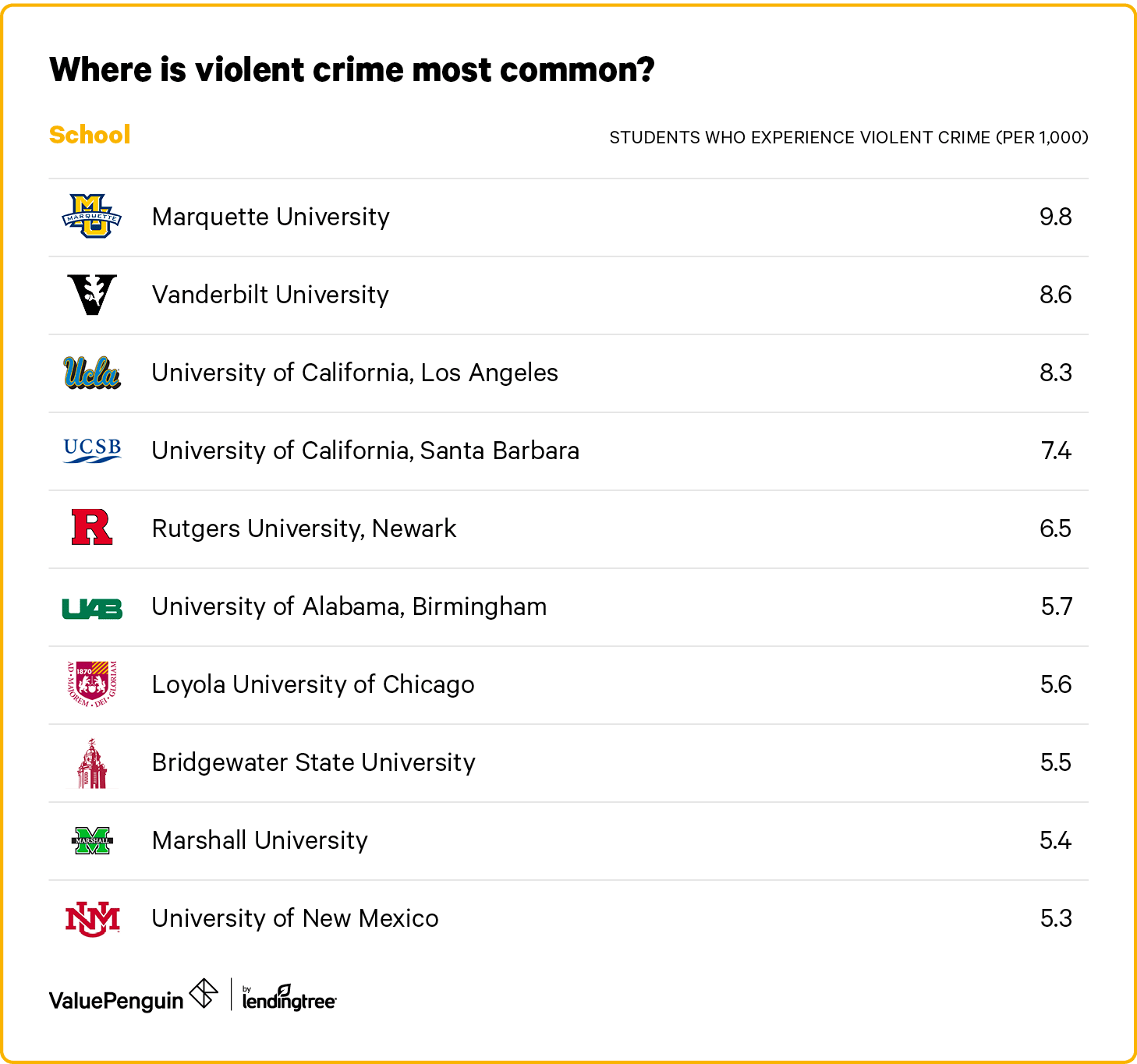
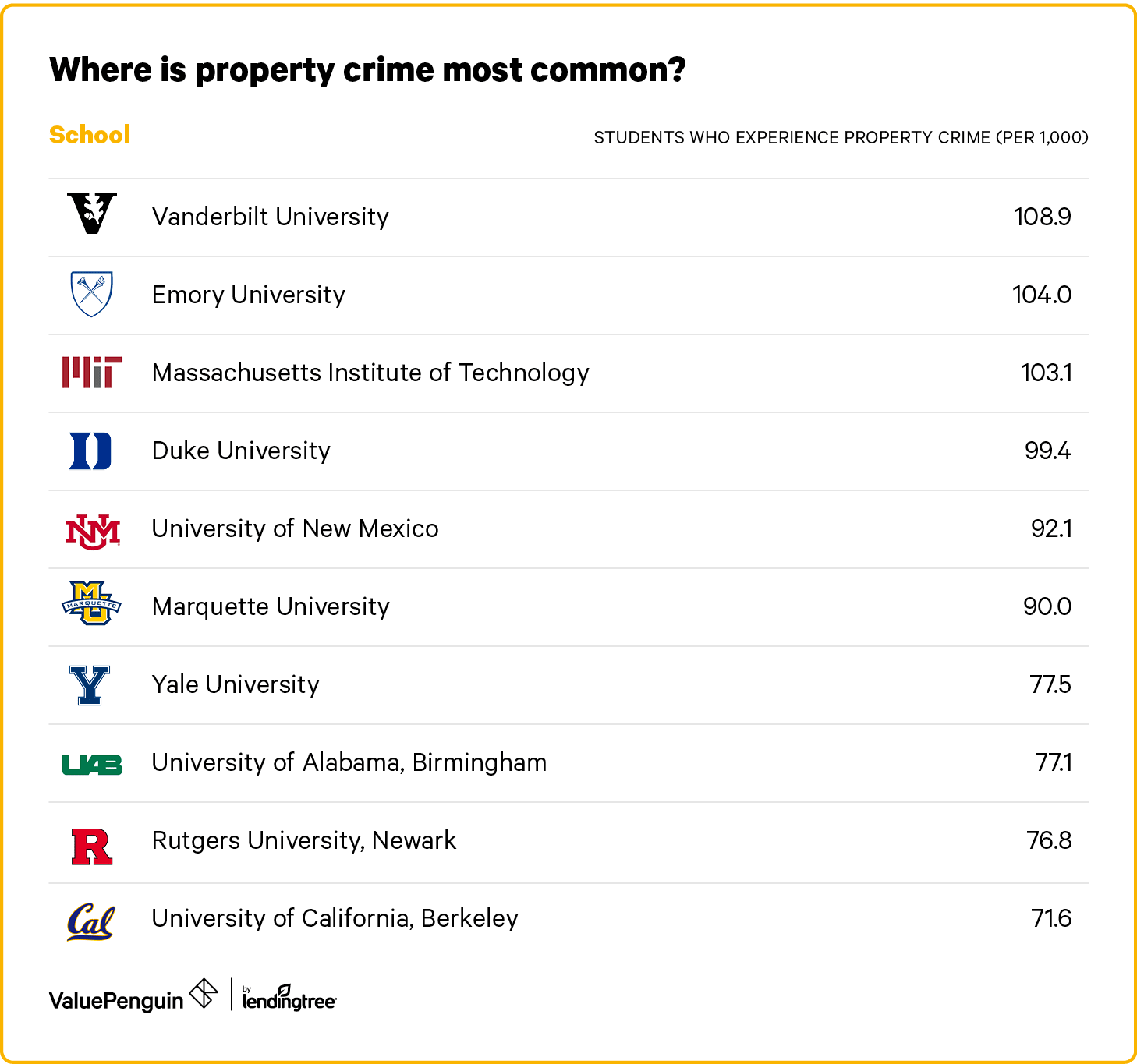
Urban colleges aren't necessarily more dangerous than rural schools
It's often assumed that urban colleges are more prone to crime than other types of campuses. However, most of the schools with low crime probability in the country are urban or suburban. In fact, among the top 20 safest colleges in the country, there is only one rural campus.
It's more likely that colleges that are close to or a part of major cities tend to be impacted more negatively by crime. For example, the colleges with the most crime are adjacent to very large cities, including Atlanta and Boston.
Compare the populations of these major cities with those that border the safest colleges. For example, the largest city of the top five safest colleges is Orem, Utah, which has a population of fewer than 100,000 people.
What role does law enforcement play in a college's crime rate?
We did not find that schools with fewer law enforcement personnel experienced more crime. Instead, many of our picks for safest schools employ smaller forces of full-time civilian and professional law enforcement officers. For instance, Florida SouthWestern State College has about 28 full-time law enforcement personnel or 1.6 per 1,000 students.
In all of the cases we examined, schools did not employ more than 20 officials per 1,000 students. Moreover, in most schools, law enforcement personnel don't exceed more than two per 1,000 students.
Vanderbilt, which experiences the most property crimes per 1,000 students, also has the most full-time law-enforcement employees of the schools we surveyed. There are still only about 19 full-time officers per 1,000 students on Vanderbilt's campus.
What can students do about crime on campus?
Although it's unlikely your student will experience crime at college, you can still take steps to protect against this possibility. You can start by exploring options for health and renters insurance.
Most typical homeowners insurance policies cover students living in college dorms, but the large deductibles that come with homeowners insurance policies might prevent students from making claims on stolen items. Furthermore, even if the value of the lost property exceeds your homeowners insurance deductible, making claims can cause premiums to increase in the future.
It's better for your student to purchase their own . Many companies, such as Lemonade, Liberty Mutual and State Farm, have cheap rates that allow policyholders to insure property worth less than $10,000. Additionally, some insurers specialize in property-only policies made for college students who don't have a lot of assets.
If you're concerned about violent crime, you could check your options for free or low-cost health insurance if your student can't get coverage through your plan. Medicaid could be a free option if you qualify. Your student could also purchase health insurance through their university's plan.
Methodology
For this study, we analyzed crime data published by the FBI. We checked four data tables in the series "Offenses Known to Law Enforcement, by State by University and College" corresponding to 2015 through 2018.
The FBI's data represents the volume of violent and property crimes as reported by university/college law enforcement. Schools are included in the FBI's dataset as long as their law enforcement offices submit 12 months of data for a given year.
We judged schools based on the probability of students encountering property crime and violent crime within a four-year span, representative of the length of time required for most bachelor's degree programs. The rates of violent crime are low for even the most dangerous schools, so our rankings prioritize property crime — always much more frequent.
Violent crime refers to murder and negligent manslaughter, aggravated assault, robbery and rape. Rape is a large part of crime on college campuses, but it's reported differently in each state, jurisdiction and school.
Property crime is comprised of reported acts of burglary, larceny, motor vehicles and arson.
We surveyed every school with more than 10,800 students in 2018, the median number of enrolled students in all the colleges and universities included in the FBI's dataset for that year. We computed the average student enrollment for these schools from 2015–2018.
Then, we calculated the average rate of violent and property crime per year, per institution. Using these average rates of crime, we calculated the chances of students experiencing property and violent crime by performing binomial distributions, per 1,000 students. A binomial distribution figures the probability of something happening in a time period given a known rate of change — in our case, the probability of a student experiencing crime over a four-year period.
We ordered our safest schools according to each institution's average place on both the violent and property crime lists: a school that experiences the least amount of violent crime and the fourth-least property crime has an average position of 2.5.
We also found the number of law enforcement officials per 1,000 students using the FBI's "Full-time Law Enforcement Employees, by State and University and College" from 2018.
